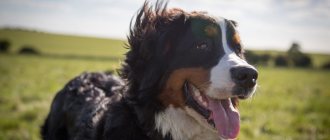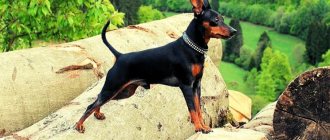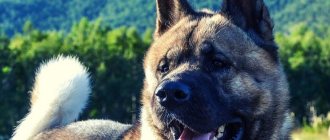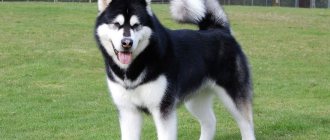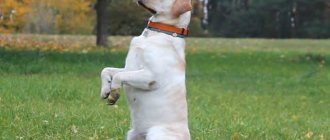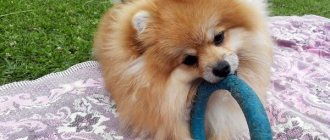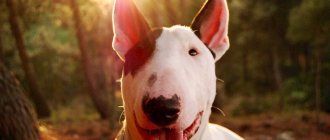Raising a dog is about developing correct behavior. This is the basis for successful training. Training is a set of activities aimed at training specific teams. It is necessary to start raising a puppy from the very first days of his appearance in the house. If you work with your pets from a very early age, then you are on the right track.
The Samoyed is an excellent companion and family friend. Initially, the breed was used for hunting and transporting sleds. This breed's responsibilities include stalking prey and keeping their owners warm when they sleep with them at night. Since they are a working dog, they can be strong-willed at times, but are still friendly, gentle and loyal family dogs.
- Country of origin : Russia
- Height at withers : female: 48–53 cm, male: 53–60 cm
- Weight:15-30
- Lifespan : 12-15 years
- Use : companion dog, shepherd, hunter, sled dog
- Other names : Samoyed Laika, Samoyed dog, Samoyed Spitz
When to start training a dog
As soon as a Samoyed puppy appears in your home, immediately begin to build a relationship with him. From the first day it is necessary to provide him with everything he needs: bowls for water and food, collar, leash, bed, suitable food, toys and of course treats. You need to give him a lot of attention so that he feels safe and begins to trust you. From a very early age, a Samoyed puppy must be introduced to commands. In addition, in the first months it is necessary to study commands both at home and on the street. First, the puppy must remember its name. We wrote how to choose a suitable nickname in one of our articles. The name should be short, easy to remember and the dog should be called only by it. When the pet has already mastered its name and finally begins to respond, then we move on to commands. By the 3rd month he should master the following commands: “Ugh!”, “Come to me!”, “Place!”, “Nearby!” and “Fetch!” (optional). Then you can move on to the rest, of course, if you need them.
What vaccinations are needed?
Vaccinations are given by a veterinarian in the clinic or called to your home.
Anthelmintic drugs are given 10 days before vaccination . The puppy must be healthy.
It is recommended to use vaccinations from such manufacturers as MERIAL (Eurikan, PrimoDog), INTERVET (Nobivak), Fort Dodge Animal Health (Duramune MAX). The latter is the most modern and safe vaccine.
Vaccinations are given according to the following schedule:
- first - at 6 weeks
- second - at 8 weeks
- third - at 12 weeks
- simultaneously with the third or after 2 weeks rabies vaccination
- Vaccinate annually against leptospirosis, plague and rabies.
We must not forget about the anthelmintic before vaccination, otherwise the vaccinations will need to be repeated again.
Features of the Samoyed breed
Samoyeds are highly trainable, but they require a special approach. The history of the breed has left its mark on the character of the dog. The main difficulties in the learning process arise due to the highly developed intelligence of the dog. Initially, they independently explored the world, made decisions and trusted only themselves. Now this is interpreted as stubbornness and independence. Boring activities can backfire. However, if you can interest the dog, you will achieve amazing results. During training, you should not shout or punish the dog for disobedience.
Dossier
Adult height: 53 - 69 cm (male), 48 -53 cm (female). Weight: 20-30 kg. Characteristic color: white, cream with tan. Coat length: double structure (short dense undercoat and long outer coat). Life expectancy: 12-14 years. Advantages of the breed: very attached to the owner and friendly, quite intelligent and quick-witted. They do not require special care and are odorless. Difficulties of the breed: require intense exercise and active walks. Average price: $250-1100 depending on the pedigree and purpose of the dog. Classification: medium breed, sled dog and companion dog.
How to raise a Samoyed puppy
If you train your pet correctly, then over time you will get an obedient dog that will follow all commands and delight you every day. Experts believe that several factors may influence the Samoyed’s susceptibility to following various commands:
- pet's temperament - the speed of the pet's reaction to stimuli, both positive and negative;
- character - how exactly the dog resists various unpleasant influences;
- obedience - the dog’s ability to accept human leadership;
- vigilance - the speed with which the dog notices potential danger, both in relation to itself and in relation to the owner;
- aggressiveness - the pet’s ability to react hostilely to potential danger;
- curiosity - interest that is developed when a dog feels, hears and sees something;
- sociability - the ability to interact with people;
- possessiveness is the interest shown by animals in certain objects, for example toys.
How quickly your dog will learn commands depends on which traits predominate in the character of a Samoyed puppy. By paying attention to the character traits of your animal, you can find an approach to it and adjust its behavior in certain situations.
- Eagerness will get you nowhere . You should not try to teach your Samoyed puppy all the commands at the same time; you need to learn the commands one by one. You need to have patience and act methodically. You should not scold your pet at the moment when he makes mistakes, and when he succeeds in something, then the pet should be encouraged.
- Don't hit . It is prohibited to use physical punishment against a pet. You should limit yourself to variable intonation, but avoid shouting. Once a Samoyed puppy is three months old, it is allowed to use a light spank as punishment while saying the phrase “Ew.” It is necessary to punish immediately when the animal commits an offense, and not after it, since the animal simply will not understand what exactly it was punished for.
- Subsequence . The main goal is to ensure that the pet follows the command the first time. Commands should be pronounced clearly and in an even voice so that the dog understands and obeys you. All family members should be involved in raising the dog, but they must act together. It is forbidden to allow situations in which you scold the puppy, and another family member praises him or simply does not pay attention.
- Pamper . Remember to reward your Samoyed puppy with a variety of treats and praise when he has done what is asked of him.
Character
By nature they are exceptionally peaceful and good-natured, although they can become capricious if there are errors in their upbringing.
Samoyeds are not the first to get into fights with other animals, but they are capable of standing up for themselves. In a critical situation, the pet will be able to come to the aid of its owner. There are many cases where an animal found its way when the situation looked hopeless.
It should not be used as a watchman. This role is not suitable for his character: he will not guard property, angrily snapping at strangers.
Basic commands
You will use some commands more often, others less often. But they will still come in handy to easily interact with the Samoyed and even keep him safe in various situations.
- Aport. One of the most difficult teams. Many people perceive it as very easy and simple, but with many dogs you will have to work hard. This skill is used for other exercises: searching, searching, selecting an item and many others. Usually they are all used in service. When working out a command, “Aport” and “Give” are used, and a gesture is also used.
- Give. On the command “Give” the dog must give up the object.
- Lie. A connecting command that needs to be learned for other commands. In addition, it will not interfere at home or on the street.
- To me. You will need to use this command quite often. So start with it immediately after your Samoyed puppy has learned his name. Never call the dog to punish, and do not scold if it comes on its own, even after mischievousness before it. This behavior on your part may alienate the animal.
- Place. A puppy or an adult dog must clearly know where his place is located. He can sleep anywhere, if you allow it, of course, but he must know this command. You can use it outside the home, marking the place with a leash or your favorite toy.
- Near. It is possible to teach your pet the “Near” command at any age, be it an adult dog or a small puppy. When you move to a new home, you should immediately think about training your puppy.
- Sit. One of the very first commands that a Samoyed puppy should learn.
- Stand. The command is useful in everyday life, for example, for combing a dog.
- . The prohibiting command is one of the most mandatory and taming it begins from the first day the puppy appears in the house. Requiring the command “Fu!”, “No!”, “No!” - immediately stop the unwanted action.
Human-animal communication
Animals helped the Samoyed tribes hunt, herd livestock, and move long distances. Some sources even claim that dogs nursed Samoyed children.
These useful qualities of animals and their stately appearance attracted foreign experts.
English zoologist Ernst Kilburn-Scott at the end of the 19th century. lived for several months with the Samoyed tribes. He took several Samoyed dogs with him to Europe.
The first in Europe was a Samoyed named Sabarka. Next, a bitch named Whitey Pechora went to England, and after her they brought a male dog, who was named Musty. Western Samoyeds originate from these animals.
Ernst Kilburn-Scott organized the first dog kennel.
Animals began to enjoy particular popularity due to the fact that they participated in expeditions to the South and North Pole.
However, after the outbreak of the First World War, exploration of the northern territories became difficult, which led to the temporary decline of this breed in Russia.
A new impetus to the development of the breed was given only in 1989, when the Polish woman Beata-Katarzyna Sarley brought two Samoyeds to Russia. Sarley subsequently took the dogs to her homeland (Poland), but several dogs from their litter ended up in Moscow. However, the Samoyed dog is still a rare breed in Russia.
Raising a dog
Education is the process of shaping Samoyed behavior acceptable to the owner, when this behavior is not regulated by commands.
During upbringing, a dog develops relationships with its owner, family members, passers-by, behavior in the house, on the street, and relationships with other dogs. The training process begins immediately when the dog first appears in the house and continues throughout the dog’s life. Regardless of the dog's breed, it must be trained. Just as people do not like ill-mannered people, dogs should also know what is allowed and what is not allowed. Raising a dog is a rather complex process, which is not limited to learning just a few commands. The main goal of education is that the dog should become pleasant to talk to. In addition, it must be manageable at some points, otherwise it will be very difficult for the dog owner. In the broadest sense of the word, dog training is about teaching the dog commands such as “Bad” and “No”. But besides this, the dog must know what is good and what is bad, even in those moments when the owner is not around. Some believe that the Samoyed only understands commands, but cannot generalize. Only those who, as a rule, never had dogs, and studied them only in laboratory conditions, in which dogs were not able to show their full potential, are convinced of this, as well as those who, due to their personal qualities, were unable to establish a relationship with pet. In real life, the Samoyed is a pack animal and therefore, like any other pack animal, needs to communicate with members of its family. In this situation, the dog’s family members are people. It is quite stupid to think that if a dog caresses you, this means that his skin is itching. In order for a dog’s nervous system to function normally, it needs affection, love, communication, and praise. In addition, so-called “inhibiting factors” are required, because if the dog is allowed everything, then this will not lead to anything good. When raising a Samoyed puppy, you should pay attention to the genetic characteristics of the breed. A family is a pack in which there must be a leader, in this case the leader is a person. The leader punishes, plays, feeds, caresses, praises and scolds. All other members of the owner's family are ranked by rank. At that moment, while the puppy is small, all other family members are senior to him. However, in the process of growing up, around the age of one year, the dog begins to look for its place in the hierarchical pyramid. Naturally, she will try to take the step that is as high as possible. She can do this with the help of force, in the case of large dogs, or with the help of cunning, as small dogs do. The more ill-mannered the dog is, the more difficult this process will be. If the owner from the first days shows his pet that the one who has the power is right, then he will turn out to be a frail neurotic or an evil beast with whom you will hardly communicate with joy. A Samoyed puppy must understand that he must obey people, since they love him, feed him, and raise him. Understand that prohibitions are not the whim of the owner, but a way to protect everyone from trouble. The main influence on the dog should be the voice. From the first days of being in your home, the puppy must realize that you love him, and if you raise your voice, then this means that he is doing something wrong. One of the best incentives for a pet is considered to be a treat, which should be given out for good behavior and listening to commands. Samoyed training and education
Care and maintenance
When purchasing a Samoyed dog, ask the breeder about how the baby ate. Try to follow the stated diet and feeding schedule as much as possible until the dog gets used to its new environment. Transfer your dog to the planned diet gradually - this will relieve digestive problems.
The decision on what kind of food - dry or natural - to feed the animal is made by the owner. It is advisable that factory-made feed belong to the premium category or higher. They contain all the necessary ingredients for normal development in balanced proportions. It is possible to create a complete diet from natural products, but this involves additional hassle, for which owners sometimes simply do not have time.
Even using ready-made food, it is useful to introduce fish dishes into the diet of a growing Samoyed, which he (unlike other dogs) loves very much.
Northern dogs also enjoy eating cottage cheese, which should be part of the daily menu. It is better to give it in the morning and make sure that the fat content of the product does not exceed 18%.
Don’t forget to add vitamins to your diet for coat and proper bone formation.
The snow-white luxurious Samoyed coat is a source of special pride for the breed. It does not get wet from snow or rain, and has an amazing ability to self-clean due to the presence of natural oils. Frequent bathing can impair this remarkable ability and may also cause your dog to develop skin problems or colds. The exception is paws, which need to be washed after every walk. The frequency of “bath” procedures for Samoyeds is 1-2 times a year. Exhibition animals are bathed more often and only with the use of professional shampoos designed for this type of coat.
Protect the animal's eyes and ears from water and detergent getting into them. After bathing your pet, dry it with a towel, dry the fur with a hairdryer, while combing it in the direction opposite to growth.
A dog's shedding will not cause you as much trouble as it would be logical to assume at first glance. Females shed twice a year, males only once. The process lasts no more than two weeks; the rest of the time the Samoyed dog does not lose hair at all. Systematic combing with special combs will reduce the shedding time. Another undeniable advantage of Arctic Spitz wool is that it is odorless.
The coat of a snow dog has excellent heat-insulating abilities, so Samoyeds can withstand not only extreme cold, but also heat. The only thing you absolutely cannot do is walk your pet under the scorching rays of the sun.
The size of the animal is not a problem for keeping in a city apartment. Determine a permanent place for the Samoyed in a cooler part of your home. The litter should not be soft and kept clean. It is desirable that from its place the Samoyed husky can control all the events taking place in the house: as a member of the pack, it should be aware of what is happening.
Teeth care involves brushing them weekly with a special toothpaste. It is recommended to wipe the ears with a dry soft cloth once a month. Samoyed dogs do not have their nails trimmed; they get worn down during walks.
You need to walk your pet at least twice a day, each exercise lasting at least an hour. If possible, devote as much time as possible to physical activity and active games on weekends.
Training at 3 months. Socialization
Three months is an important stage in a Samoyed husky puppy’s introduction to the outside world. Your first walks should be short and not too tiring for the puppy. You should start with 15 minutes, gradually increasing the walking time to 1 hour.
Correct formation of the nervous system
At this age, the puppy’s nervous system is forming. It has been proven that raising puppies in isolation during this important period contributed to the development of pronounced cowardice in them later. It is necessary to show the puppy as much as possible: noisy streets, large crowds of people, etc. Everything that he will have to face in later life.
This must be done very carefully, gradually, over and over again increasing the time spent in noisy places, so as not to overload the puppy or frighten him.
The territory of a country house, cottage or village are places with a minimum amount of external stimuli for a city dog. Therefore, if you plan to keep a dog in an urban environment, “growing up” a Samoyed husky puppy in such conditions depleted of irritants is unacceptable.
A city puppy must grow up in the city, in conditions that are saturated with external stimuli, such as: noisy streets, large crowds of people, other animals, birds, cyclists, cars, etc.
Meeting people and dogs
It is necessary to introduce the puppy to friendly dogs and people so that later the puppy does not develop aggression or cowardice caused by the fear of new things and the inability to communicate and make new acquaintances. Currently, unfortunately, this is not uncommon in the behavior of adult dogs, but a fairly common problem with which people turn to our specialists for help.
Puppy behavior on the street
The emergence of new places leads to new rules that need to be consolidated:
- Now you can and should go to the toilet on the street, and not stoically endure it, carrying everything home;
- Not every new person or dog wants to communicate, so you don’t need to run headlong to meet everyone;
- Not all food is healthy, so it should only be taken from the owner’s hands.
Training and practicing commands
Training a puppy follows the same principles as at 2 months. It should be remembered that at this age puppies develop conditioned reflexes quite easily, but they are forgotten just as quickly, so you should not scold the puppy for not following commands, especially if they have not been repeated for a long time, but you should pay more attention to learning new things and repeating already covered material .
Training at 4 - 5 months
By this time, the Samoyed husky puppy has already become accustomed to your home and usual walking areas, and no longer needs your support and care so much. He begins to flirt with other dogs, pretend that he does not hear you when you call him, and show a certain persistence and disobedience when performing various commands.
This means it’s time to move on to full training. In classes at this age you can already be persistent and demanding. At the same time, the most important thing is not to overdo it, remember that classes should bring joy to both you and your dog, and only then you can achieve the desired result.
Required commands in 4 months
What commands are practiced by a Samoyed husky puppy at 4 months:
- Calm movement next to the owner with and without a leash, with landing when stopping, with a change in pace and direction of movement
- Return to you on command
- Exposure in a free or certain position (sitting, lying, standing)
- Indifferent attitude towards treats scattered on the ground
- Inhibitory command to stop unwanted actions
- Execution of a set of commands “sit”, “lie down”, “stand” at a distance and near the leg, when giving commands by voice and gestures
- Stop barking on command.
Training options:
- Individual program
- Wherever it's convenient for you
- At a convenient time for you
- Training and behavior correction
More details about the service →
Live-in training with a dog handler
- Comfortable conditions of detention
- Daily training sessions
- Your pet's usual daily routine
- Training and behavior correction
More details about the service →
Individual ONLINE lessons
- Maximum urgency
- Anywhere in the World
- At home and on the street, wherever there is Internet.
- Training and behavior correction
More details about the service →
